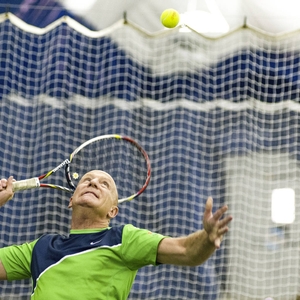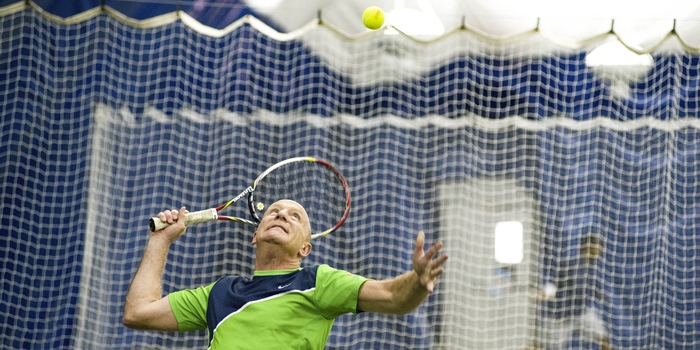Father-Daughter Bonding With Tennis Strings Attached
March 31, 2018
A hotel executive carves out quality time with his grown daughters by playing doubles with them in national tournaments.
Fathers can struggle to connect with their teenage daughters. Steve Heitzner bonded with his two girls by becoming their doubles partner in father-daughter tennis tournaments.
At 59, the chief sales and marketing officer for Marriott International’s Americas group plays tennis constantly after years away from the sport. He’d played on Michigan State University’s team in college, but as he transitioned into the corporate world he was down to playing once or twice a year.
That changed two decades ago, when he moved his family to Scottsdale, Ariz., and found a group of friends who played tennis. He discovered his game had actually improved, thanks to the endurance he’d built up from long-distance running.
He used his rekindled love of the sport to bond with his daughters, Jordan, now 28, and Kendall, now 24. At the time, the girls were just getting into tennis. “I got to travel all over the country to junior tournaments with my dad,” Jordan says. “He was always there to scope out the competition and pump me up for my matches.”
By the time the girls were teenagers, the family was living in Southern California. Mr. Heitzner heard about the U.S. Tennis Association’s Father-Daughter Hardcourt Championships in San Diego and in 2008 entered with Jordan, who was then 18.
When she went off to college Mr. Heitzner began competing with Kendall. “They have totally different styles,” he says. “Jordan is a retriever. She loves to run down the ball. Kendall wants to kill the ball and have a play be over in one shot.”
The USTA holds four national family tournaments on different surfaces—hard courts, grass, clay and indoors—in categories including father-daughter, father-son, grandfather-grandson, husband-wife, mother-son and mother-daughter.
Mr. Heitzner and Kendall became the second-ranked father-daughter team in the country in 2013.
Both daughters moved on to high-level college tennis careers. When their schedules align now they still practice and compete with Mr. Heitzner, who lives with his wife in Potomac, Md.
The Workout
Mr. Heitzner plays tennis any chance he can get. Locally, he plays with both daughters at Bethesda Country Club. He also regularly practices with colleagues who are ex-college players. On Friday nights he plays in a competitive league in Bethesda with local tennis pros and former college players from 20 to 60.
Mr. Heitzner estimates that he’s on the road 60% of the year. “I try to make tennis a priority,” he says. He asked his daughter’s Brazilian tennis coach to set him up with a local pro when he traveled to Brazil. In Rome, his request for a tennis pro got lost in translation. “They thought I just wanted a court, so I ended up 30 minutes outside of the city without an opponent,” he says. “Finally someone understood my request and found me two pros who played with me for two hours”
Mr. Heitzner works out seven days a week at home, at the company gym or a hotel gym. He feels low-energy when he misses a day. Having had his hip replaced two years ago, he opts for the elliptical machine over the treadmill. “I try to keep the pounding for the court,” he says. He aims for an hour of cardio a day. He lifts weights and focuses on muscles he uses in tennis, including core and upper back. “I stick to light weights,” he says. “In tennis you want to be lean and strong rather than bulky.”
The Diet
A nutritionist told Mr. Heitzner 10 years ago that with his lifestyle and travel schedule, he needed to eat a consistent breakfast. “So for 10 years I’ve eaten an English muffin with peanut butter every morning,” he says. Chicken Caesar salad is a lunch staple. Dinner is usually out and he orders chicken or fish and occasionally steak. “I know you’re not supposed to eat a lot of red meat, but I figure I work out enough so I can enjoy a steak,” he says. He fuels himself with Power Bars and Clif Bars during competitions. Pizza is his splurge.
The Gear & Cost
Wilson discontinued its Steam BLX model, but Mr. Heitzner can still find the racket on eBay from $90 to $160. He will only use Tecnifibre Black Code string ($15). He restrings his racket once a week. He wears Wilson tennis shoes and recently started hitting the gym in Altra sneakers. “They look kind of like clown shoes, but they are actually shaped just like your foot, with a boxy front for your big toe.”
Age With Tennis Gracefully
Tennis has long been recognized as the rare sport that you can enjoy for a lifetime. “While older players might not be able to bomb their serves like they once did, or race for drop shots like a collegiate athlete, they do gain tactical experiences over decades of play,” says Bill Mountford, senior racquets director at Chelsea Piers Connecticut in Stamford.
Older players can usually still hit the ball well. Getting to the ball, or maintaining explosiveness or quick and balanced footwork, is what gets tougher with age, Mr. Mountford says. Anticipation skills, knowing when and how to move to where the opponent will hit the ball, take years to develop but can make an older or even out-of-shape player appear quicker than younger and super-fit players. Mr. Mountford calls a proper warm-up and a post-match cool-down crucial for aging players.
“Light stretching and a cool down jog or walk is also paramount to recovering and not feeling sore the next day,” he says.

